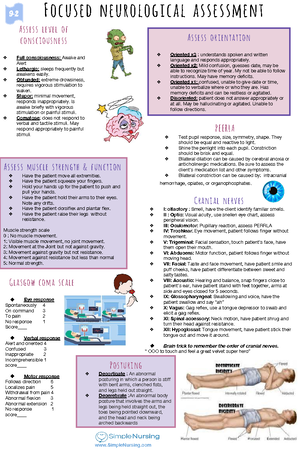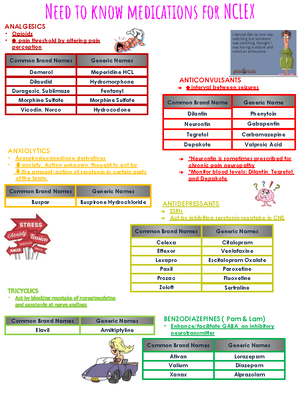- Information
- AI Chat
Was this document helpful?
Cc 0 orientation - EKG and Hemodynamics
Course: Critical Care (408)
18 Documents
Students shared 18 documents in this course
University: Loma Linda University
Was this document helpful?

Normal Breath
Sounds
inspiration >
expiration
low pitch
soft
no adventitious
sounds
Vesicular Breath
Sound
most of lung field
low pitch
soft & short
exhalation
long inhalation
Bronchovesicular
Breath
heard over main
bronchus upper
right posterior lung
field
medium pitch
exhalation =
inhalation
Bronchial Breath
Sound
trachea only
high pitch
loud and long
exhalation
Crackles
excessive secretions/fluid
in airway
short, discrete
popping/crackling sounds
associated w/ PNA,
pulmonary edema,
pulmonary fibrosis,
atelectasis
Wheezes
vibrations when air flows at
fast speed through narrow
airway
high-pitched, squeaking,
whistling sound
associated w/ asthma or
bronchospasm
Pleural Friction Rub
produced by irritated pleural
surfaces rubbing together
creaking, leathery, dry,
coarse, sound
associated w/ pleural
effusion, pleurisy
Absent
no airflow to particular
portion of lung
associated w/ pneumothorax,
pneumonectomy, lung mass,
complete airway obstruction
Diminished
little airflow to particular
portion of lung
sound intensity is reduced
associated w/ atelectasis,
COPD, obesity
Stridor
sign of obstruction in
trachea or larynx
loud, high-pitched sound
(sounds like snore)
wake pt. up to r/o stridor if
awake & still has snoring
sound positive for stridor
Chest Tube Nursing Actions Chest
Tube
always keep drainage
system below level of chest
& free of kinks
troubleshoot cause if there’s
change in previous
assessment
if cause can’t be confirmed
notify physician
ALWAYS have sterile
Vaseline gauze on hand in
case of accidental
dislodgement
if chest tube comes off
apply pressure on insertion
site w/ sterile Vaseline
gauze and call physician
Value of ScvO2
remove fluid & air from
pleural space
three chest tube settings
suction
water seal (to gravity)
clamped
assessed if pt. can
tolerate function
without chest tube or if
they don’t need chest
tube anymore
air leaks
bubbling in the drainage
system
assess and identify cause
every shift
central venous oxygen
saturation
normal: 70 – 80%
ScvO2 can be used as
convenient surrogate to a PA
catheter for
detection & rapid TX of
tissue hypoxia
sustained ScvO2 <70%
associated w/ higher
mortality
Arterial Line (A-line, ABP) Central Venous Catheter
(triple lumen CVC, CVL)
Pulmonary Artery Catheter
continuous monitoring of
ABP
non-traumatic sampling of
arterial blood gas (ABG)
do NOT infuse
continuous monitoring of
central venous pressure
monitoring of central
venous oxygen saturation
(ScvO2)
reserved for most
hemodynamically unstable
patients for diagnosis &
evaluation of heart dz,
pulmonary HTN, shock













